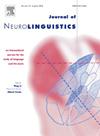The missing link between response selection and execution in language production
IF 1.2
3区 心理学
Q2 LINGUISTICS
引用次数: 0
Abstract
In this review, challenges related to the measurement of word durations in language production are identified, highlighting gaps in current theoretical frameworks and the resulting difficulty in interpreting available evidence. To compensate for limited theoretical predictions regarding response durations in spoken language, we turn to other fields, such as written production and motor control, to provide informative analogies. In written production, reliable effects on durations have been observed but the field similarly suffers from the absence of clear predictions from the available models, limiting interpretations. Since word durations are the result of motor programming and execution, evidence from motor control is particularly relevant. Recent theoretical proposals suggest that planning and execution stages overlap in time, with response planning continuing even after the initiation of the motor response, making variations in durations arise from either planning or execution processes. In addition, they propose a gating mechanism to launch response initiation. Similar dynamics could be easily assumed in language production, which could help bridge the gap from response selection to response execution and extend current models of language production to account for motor execution and predict word durations. We end by outlining pending questions for the field of language production, and some recommendations to tackle them in the future.
语言生产中反应选择与执行之间缺失的一环
在这篇综述中,识别了与语言生成中单词持续时间测量相关的挑战,强调了当前理论框架中的差距以及由此导致的解释现有证据的困难。为了弥补关于口语反应持续时间的有限理论预测,我们转向其他领域,如书面生产和运动控制,以提供翔实的类比。在书面生产中,已经观察到对持续时间的可靠影响,但该领域同样受到现有模型缺乏明确预测的影响,限制了解释。由于单词持续时间是运动编程和执行的结果,来自运动控制的证据尤其相关。最近的理论建议认为,计划和执行阶段在时间上是重叠的,即使在运动反应开始后,反应计划仍在继续,这使得计划和执行过程的持续时间发生变化。此外,他们还提出了一种启动响应启动的门控机制。类似的动态可以很容易地在语言产生中假设,这可以帮助弥合从反应选择到反应执行的差距,并扩展当前的语言产生模型,以解释动作执行和预测单词持续时间。最后,我们概述了语言生成领域有待解决的问题,并提出了未来解决这些问题的一些建议。
本文章由计算机程序翻译,如有差异,请以英文原文为准。
求助全文
约1分钟内获得全文
求助全文
来源期刊

Journal of Neurolinguistics
医学-神经科学
CiteScore
3.90
自引率
5.00%
发文量
49
审稿时长
17.2 weeks
期刊介绍:
The Journal of Neurolinguistics is an international forum for the integration of the neurosciences and language sciences. JNL provides for rapid publication of novel, peer-reviewed research into the interaction between language, communication and brain processes. The focus is on rigorous studies of an empirical or theoretical nature and which make an original contribution to our knowledge about the involvement of the nervous system in communication and its breakdowns. Contributions from neurology, communication disorders, linguistics, neuropsychology and cognitive science in general are welcome. Published articles will typically address issues relating some aspect of language or speech function to its neurological substrates with clear theoretical import. Interdisciplinary work on any aspect of the biological foundations of language and its disorders resulting from brain damage is encouraged. Studies of normal subjects, with clear reference to brain functions, are appropriate. Group-studies on well defined samples and case studies with well documented lesion or nervous system dysfunction are acceptable. The journal is open to empirical reports and review articles. Special issues on aspects of the relation between language and the structure and function of the nervous system are also welcome.
 求助内容:
求助内容: 应助结果提醒方式:
应助结果提醒方式:


